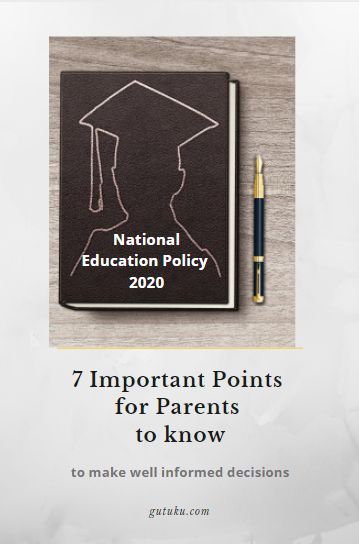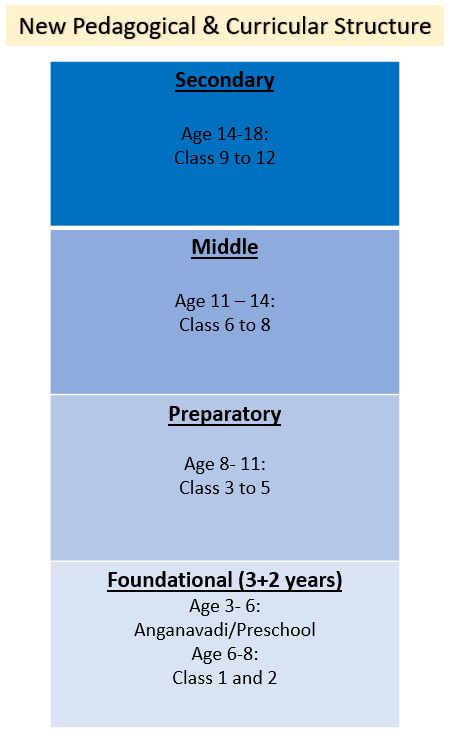Union Cabinet approved National Education Policy 2020 (NEP 2020) on 29th July 2020. This new policy aspires to make “India a Global Knowledge Superpower”. So, it has come up with huge reforms in the Indian Education System.
As one of the key stakeholders, parents need to be aware of upcoming changes in the education system. This helps them to make well informed decision for their children.
So, let us try to understand the proposals of National Education Policy 2020.

1.Change In Academic Structure
- Current 10+2 (6 to 18 years) structure will be changed to a new pedagogical and curricular structure of 5+3+3+4. It covers 3 to 18 years of age.
- Home language/mother tongue/local language/regional language to be used as medium of Instruction until grade 5 , preferably till grade 8. Three languages formula will be introduced. States, Regions and Students will have the flexibility to choose the language.
- Vocational courses will be introduced in the curricular.
- Students can design their learning path by choosing the subjects starting from secondary level. This helps them to align their learning with life goals.

2.Importance to Early Childhood Care and Education (ECCE)
- Pre-Schools/Montessori schools are very much prevalent in Urban part of India. But, it doesn’t come under the current 10+2 structure. New policy is making Early Childhood Care and Education (ECCE) a part of formal education system.
- A National Curricular and Pedagogical Framework for Early Childhood Care and Education (NCPFECCE) will be developed by NCERT. This will have two sub – frameworks (0-3 years and 3-8years), which are going to be aligned with the policy guidelines, national and international best practices.
Related Read – Montessori Education System
3.Change in Assessments format
- Current Summative Assessment pattern focuses on testing memorization abilities, because of which rote learning is promoted. So, this will be replaced with Formative assessment pattern.
- This new format will focus on testing the competencies. So, evaluating analytical thinking, critical thinking and conceptual clarity will be the main aim of assessments.
- Progress of the child in all the aspects will be reported. Because of this, there is a need to re-design the report cards.
- Board exams will test core capacities/competencies rather than months of coaching and memorization.
- Option to appear in Board exams up to 2 times (in any given school year), if the student desires to improve the scores.
4.Standard-setting and Accreditation for School Education
- Directorate of School Education will work independently to implement the policies related to education.
- An effective self-regulation or accreditation system will be introduced to empower the education at all levels.
5.Changes in Higher Education
- Policy highlights the need to bring back multidisciplinary approach in Educational Institutions. Because, multidisciplinary Education imparted in institutions like Nalanda, Takshashila have proved to create Innovative well-rounded individuals. So, there will be an end to fragmentation of higher education leading to restructuring.
- Transparent mechanism to grant graded autonomy to colleges will be established through a system of graded accreditation.
- Single-stream Higher Educational Institutions(HEI) will be phased out over time. And all will move towards becoming vibrant multidisciplinary Institutions or parts of vibrant multidisciplinary HEI clusters.
- Undergraduate degree programs will have multiple exit options with appropriate certifications. For example, a certificate after completing 1 year course. A diploma after 2 year completion. A bachelor degree after 3 year completion. Degree with research if the student completes 4 year program and this is the most preferred option.
- Flexibility in Master degree programs. For example – 2nd year dedicated to complete research program if the student has completed 3 year bachelor’s program. For students completing a 4-year Bachelor ’s programme with Research, there could be a 1-year Master’s programme. There may be an integrated 5 year Bachelor’s /Master’s program.
- The M.Phil. programme to be discontinued.
6.Internationalization of Education
It is well known fact that most part of the Indian talent pool migrates to other countries to seek better standards of Education. The concept of ‘Internationalization’ introduced in this Policy can retain and attract talents, if implemented effectively.
Below are few points highlighted in the policy:
- Provide premium Education at affordable costs to promote India as Global Study destination.
- International Student Offices will be set up at HEIs hosting foreign students. This is to co-ordinate all the matters related to welcoming and supporting students arriving from other countries.
- High performing Indian Institutions will be encouraged to setup campuses in other countries. Similar way, selected Universities from other countries will be allowed to operate in India.
- Research Collaboration and Student exchange programs between Indian and Global Institutions will be promoted through special efforts.
7.Promotion of Indian Languages, Arts and Culture
India is a diverse land with rich cultural heritage. But, is that well represented and preserved for the generations to come? Our rich culture is losing its shine under the western influence. So, there is an urgent need for the ‘preservation and promotion of Indian Cultural wealth’.
This aspect is taken care in the New Education Policy. So, it includes various plans to develop and promote the knowledge of Indian languages, arts and culture at all the levels of education.
Disclaimer : Information given in this article are as per our understanding of NEP 2020. This is only for information purpose, created with the intention of bringing more awareness about the upcoming changes in Education field.


